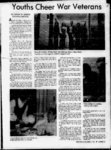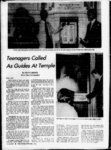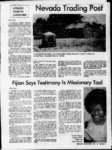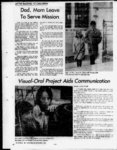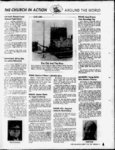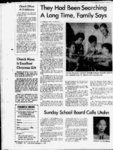| OCR Text |
1 Rebuilding Indochina DESERET NEWS SALT LAKE CITY, UTAH j We Stand For The Constitution Of The United States As Having Been Divinely Inspired j 8A EDITORIAL PAGE SATURDAY, DECEMBER 9, 1972 At Interior Require Big Men Big Jobs Utah is losing some big voices in an agency that intimately affects this state namely, the U.S. Department of Interior. Former Utahn Ellis Armstrong is definitely out as U.S. Commissioner of Reclamation, and there are conflicting reports about the future of Mitchell Melich as the Interior Departments solicitor. Thats a shame because Utahs future growth is limited by the extent to which its water resources can be developed, and the extent to which those resources can be developed is limited by how much federal cooperation we can get. Even so, there are sharp limits to how critical one can be of all the changes being made at Interior, including the removal of He also George Hartzog as director of the National Park Service. has been a friend to Utah in the establishment of parks. The White House hasnt let the public in on all the reasons for the personnel changes it is making, but we're confident they reflect a philosophy more substantial than change for its own sake. Besides, musical chairs is part of the game back in Washington, and one takes a post knowing he is subject to reall. Then, too, the public hasn't none at or reason moval for any been told who will replace Mr. Armstrong and the others involved so a full appraisal cant be made yet. As these replacements are announced, Utahns will be watching closely in the expectation that at least three standards of excellence ought to be met. First, the new appointments should reflect a close familiarity with the West, since the work of the Interior Department affects this part of the country almost exclusively. policy-makin- these are jobs that demand career professionals rather and political errand boys. Second, than yes-me- g n Third, in an era when Americans have become increasingly aware of the impact that mans excesses can have on the environment, the new appointments should reflect a balance between exploiting resources and conserving them. The key word is balance. As a broad general rule, water resources which go undeveloped are largely resources that are ed rather than conserved. But weve also seen projects which the engineers insisted were essential turn out to be projects we were able to get along without. As a result, the top policy jobs at Interior require not just technical expertise but a broad outlook. Utah is proud of Ellis Armstrong and his colleagues and of the Work ihy have done at the Interior Department. It will be hard to find better men. President Nixon will need all the wisdom he can muster as he goes about the job of casting the department in a new image. Drugs In The Schools ' ' - ' Theres room for neither complacency nor panic over the prob lem of drug usage among Utahs junior high and high school stu: dents. That point is made abundantly clear in the first of three drug reports covering 30,000 Utah students released this week. The or frequency of use of drugs and alcohol. study covers non-us- e The study suggests that while there is a relatively high perthe centage of experimenters particularly with alcohol number of habitual users drops off markedly. Thats understandable. Curiosity has always been a big factor e in use of drugs and alcohol. But that isnt the factor that makes for habitual use. Frequently that cause is psychological: Low feeling unwanted by ones peers or adults, a tento dency be a loner, among other reasons. One of the' most challenging points in the study is that while h some 80 percent of the grade students sampled know how to use and abuse drugs, only half of them know about laws on drug use, physical effects, drug dangers, and the like. If drug abuse is to be curbed, Utah has a big job of education to do both at home and at school. one-tim- After The War: Reconstruction . (As pice edges uncertainly nearer in Vietnam, so does the need for massive postwar econstruction. Even while hamlets, brides, industries, and whole towns still am Mng turned into nibble, some officials a! grappling with the tasks of of how best to use President rebuilding Nixons offered $7 billion for Indochina (with uto $2', billion going to North Vietnam1 South Vietnam has great potential for icovery, but needs peace, stabilit-y- , confidnee. The North, battered by strategic boiblng, wants reparations with no string Here are direct reports on plans from Washington and Saigon.). B DANA ADAMS SCHMIDT Christian Science Monitor News Service .9 a p, W tv - A Lesson From Japan 7 SkKT - hcS. r r yip u , SA V Hj -- G !$Ui Preslent Nixon (and President Johnson before iim) has committed the United States 1 this course. Some Americans consideiit a matter of conscience. X o has alreay had a mission visiting Hanoi. Top forth Vietnamese officials have, however, made it emphatically clear to visitors tht they do not intend to let any foreign ajency plan or execute their They are a closed group, so jealous a; their sovereignty that they would ratler forego foreign aid than permit intruson. The rejresentatives of third countries have advied Washington that the North Vietnamese would regard an American contributioi as "reparations. What they want is a check direct from the United States, butno AID mission, and no experts or advisers Nor do the North Vietnamese have much use for the United Nations, which did nothing for them during the long war; nor for theWorld Bank, which they consider to be diminated by the United States; nor for tlf Asian Reconstruction Bank, which they consider to be dominated by Japan. The; would like to avoid a financial consortium of aid givers and to deal with each donor ir lender bilaterally. In any construction plan the questions to be asked nust include: How much dam- age was doie? What is the potential for reconstructiin? North Vienam is a country devastated by a deluge of a half million tons of bombs. Its devastation differs, however, from that of South Vietnam, which has been ravaged jy an even larger tonnage of explosives. Whereas the bombing in South Vietnam has ieen characterized by tactical support f the American and South Vietnamese irmies, and carpet bombing and defoliation in the countryside where . Consequently, not a single city has been spared. Some cities, like Vinh. a communications center on the way to South Vietnam, have been obliterated once, partly bombreconstructed during the three-yea- r ing pause after 1968,. and then obliterated f or more in again. Almost all are ' ruins. All large bridges, all large electric-power and all facilities, major plants have been hit. one-hal- North Vietnam is, at present, a society devoid of amenities. The people work mainly with what is shipped in from China (small arms, essential rice, and other , Haiphongs cement and phosphate fertilizers; Viet Tri's chemical, paper, sugar, and alcohol; Nam Dinhs textiles; and Thain-guyesteel. Faced with the destruction of almost all large petroleum and nil depots, the North Vietnamese also shifted to reliance on wider scattered drums. Today, wherever one goes in' North Vietnam, these oil drums can be seen, too numerous and dispersed to be destroyed. Here is what happened in three North Vietnamese cities: Hanoi, where 50 percent of the counindustrial production was concentrats of ed, has gradually given up its population. One of the first postwar tasks of the North Vietnamese government trys . three-fourth- - the North is still a vital, vigorous land. To know how it has accomplished this is to grasp the country's potential for reconstruction . . will be to cope with food), and from the Soviet Union (heavy weapons and aircraft). It is a country where it is impossible to purchase a paper but the roughest clothing, where school children have been taught to wash and dry copy paper so it can be used dip or any again. Yet, incredibly, the North is still a vital, vigorous land, capable of resisting the strongest military power in the world, and of supporting expeditionary forces in South Vietnam, Laos, and Cambodia. To know how North Vietnam has accomplished this is to grasp the country's potential for reconstruction. Apart from ideological dedication and native tenacity and discipline, the key is. in a word, decentralization. Wherever there were factories, the mato chinery was split up and dispersed the suburbs, to the countryside, to caves in the mountains, or even to deep, jungles. Out of the jungles, now comes a trickle of cement, paper, pottery, sugar, and farm tools. d Such a system is far from efficient, but it keeps the country going. It would not a rush of people back to the towns, especially back to Hanoi. Haiphong, North Vietnams second largest city, has been compared, in degree of devastation, to Dresden, Germany. According to its deputy mayor, Hoang Tho, it suffered 230 raids since 1965. which destroyed 20.000 buildings and caused 70,000 dead and injured out of a population of a quarter-millioDamage venters on the port. Nam Dinh. which, according to local officials, was 60 percent destroyed in 40 attacks during the Johnson administration, was partly rebuilt in the bombing pause, and then 70 percent wrecked in Nixon administration raids beginning May 6 this year. Although the textile mills had been dispersed here, as in other towns, a hard core remained or was rebuilt, offering targets to the bombers. g The dispersal of the productive resources of these and other cities was made possible by a North Vietnamese flair for improvisation. To help evacuated workers separated from their families to feed themselves, collective kitchens were established. At some - An effort was made at first to evacuate all similar types of machines, such as lathes, to one area. After discovering that when one of these areas was bombed it halted the entire productive process, they then shifted to creating economic areas, with populations of about 1 million, each with a wide range of industries. The most important plants . were Hanois machinery factory, rubber products and vehicle repar and assembly; ",Incredibly , f;d a worker would drop off his stewpot on the way to work in the morning, and return to find it filled in the evening. have been possible to do it on such a scale in a more complex economy. According to Jon M. Van Dyke, writing in North Vietnams Strategy for Survival, here were 1.000 industrial enterprises in 1965. Only 200 of them were large and relatively modern. North Vietnamese and Viet Cong were presumed to be taking cover, in the North the bombing has been rtrategic, aimed especially at industries, power plants, sup-- ' ply dumps, and comnurn'cation centers which were more often than not in or near towns. n The orld Bank has had a committee lo study 'ietnam reconstruction since 1965. The Sovtt Union and Communist China, the most likely sources of technological aid, haveplenty of current firsthand information. .apanese industry has shown a keen inteest in getting in on the job. and Japanese elections for a new Diet (Parlare domestic, and yet Premier Kakuei Tanaka, iament) Sunday who is expected to win stronger control, is running more on his j WAc-- and incredibly tough of the adversary United States. being-draw- ; A' rn f w While the UnitWASHNGTON, D C. ed Stats Air Force is still destroying North 'ietnam, some agencies of the American government are quietly studying the problems of reconstructing this mountainous, The entagon and the Central Intelligence Aency have, over the years, accu-- . mulateda vast fund of information about North Vtnam, useful originally for knocking the ountry down, and now for putting it back together again. This information has bea kept secret, but now is ubn by Henry A. Kissingers staff at the Vhite House, and will soon be passed cer to Roderick OConnor, assistant adimistrator for special projects in the Agecy for International Development (AID), wio has been tagged for the - J vy self-estee- 7th-12t- - , Human losses have been kept surprisingly low with the construction of bomb conshelters shelters, including sisting cf nothing more than a deep hole along all heavily traveled roads. one-ma- n The demands of disperal have left North Vietnamese society with a deep imprint that will influence the course of reconstruction. After the end of the Indochina war North Vietnamese leaders concentrated economic development in heavy industry. Renewed war changed all that. The most recent economic plans emphasize small machinery, consumer goods, and agriculture. against the French. Ideologically, the countrys leadership s ideal of a has shifted to Mao twin on based the society pillars of industrial workers and farmers. As in other Communist countries, agriculture, although-9percent collectivized, has nonetheless remained the least successful branch of the economy. Reconstruction is likely to include an effort to acquire from abroad heavy farm equipment with which to make farm production more efficient. Tse-tung- Decentralization has given provincial officials and party cadres a new importance. The central government, in an effort to maintain control, has been obliged to expand greatly the number of its cadres. A central problem in reconstruction will be whether to maintain decentralization as insurance as was done in 1958 against future wars, or whether to gamble on peace and let industry and administration concentrate anew in the cities. The big issues in the South Has Great Potential For Recovery success in normalizing relations with China and his personal popularity. He appears to be taking a page out of President Nixons book. That is not to say that Tanaka has ignored internal problems. In fact, he has written a popular book, A Proposal For Remodthat has, itself, become a major eling the Japanese Archipelago. election issue. In the proposal., he suggests that people and industry be moved from the densely populated Pacific Coast cities into less de eloped areas in the west and north. Among key domestic issues are pollution of air and water. As Japan became the world's third greatest industrial power, it also became the world's most ' polluted nation. Citizens are now demanding their government pay attention to the quality of life along with concerns over economic grow th. Tanaka's liberal Democratic Party has been accused in the past of being slow iu respond to puliutiun problems. Astute politician that he is, however, the premier is expected to win the allegiance of both big industry and the disgruntled urban voters. It might pav American political leaders to study Tanaka's methods. Afterthoughts Tne chief difference between knowledge and wisdom is that the former knows what it knows, and the latter knows what it doesnt know. .' Even though English English shounds more attractive to the American ear than American English (compare Oliviers diction to that of any American actor, for instance)., nevertheless jtjs a .fact .that to foreigners English Is easier to understand in the .mouth of an American than when spoken hy an Englishman. T i By DANIEL SOUTHERLAND Christian Science Monitor News Service - SAIGON, SOUTH VIETNAM Despite all the figlting. bombing, defoliation, and corruption. South Vietnam has great potential for a peacetime recovery. South Vietnam still has sizable rich agricultural areas which do not suffer from the overpopulation which affects many other Asian counties. ue itrixamicu for the eventual pro- duction of newj j crops. A great deal 0f deep plowing would be required. Booby traps and unexploded bombs and shells would have to be cleared. But the Vietnamese certainly have the energy and know-hoto do the job. v.uuju The experts think that given peace. South Vietnam could again produce enough ru.e to feed all of its people within tw o or three years. Current plans call for no immediate demobilization ot the South Vietnamese Army. But if a gradual demobilization were earned out over a penod of several years, many of the men released from the Armv probably would return to the farms whicn are not being tended mainly by old men, women, and children. It is to these farms and to its fishing and forests that South Vietnam must look for recovery in the first postwar years. Scientists estimate that defoliation has destroyed about half of South Vietnam's of mangrove forests. An estimated the upland forests have suffered from moderate to severe defoliation. The scientists still are unsure of the full, long-tereffects. But the remaining forests, which are extensive, are looked to as one of the main natural assets available for the countrys recovery. South Vietnams greatest assets is its people tough, resilient, intelligent. one-fift- h Its greatest recovery problem may tun out to be its chaotic cities and towns. As a result of the war, a rural nation 80 percent of whose people used to live on farms now has at least 5C percent of its people jammed into cities and towns. The city of Da Nang, the country's second largest, is suffering from severe unemployment problems as a result of the withdrawal cf U.S. forces. No one is quite sure yet what is to be done about this. But it is expected that few of the refugees who have lived in the cities for several years will want to go back to the countryside. Some of their children don't know the first thing about growing and harvesting rice. U.S. officials are talking in terms of a continuing high level of U.S. commercial aid in order to bolster the countrys shaky economy. Under current planning, even if the fighting stops, the Saigon government will continue to have a huge American-backemilitary budget for some time to come. benefits also will be a continuing drain on the budget. In the countryside, foreign aid can be used to repair much of 'he physical damage. American aid officials say that if illustrative figure Henry A. Kissingers of $7.5 billion for the rehabilitation of all Indochina becomes a reality, this would easily cover aid to hundreds of thousands of Vietnam refugees and the repair and construction of roads and bridges. Officials estimate that 160 bridges were blown up during the recent North Vietnamese offensive. Several hundred kilometers of roads must be repaired. The towns of An Loc and Quang Tri have to be rebuilt virtually from the ground up. But all this probably could be done with some $125 million, officials say. Aid in the billions would allow for much longer-rangprojects. Hydioelectnc power projects, for which South Vietnam has a great potential cou l be included, for instance. t d e But it appears that very little hard thinking went into the $7.5 billion figure. The problem in planning for rehabilitation, say officials here, is that no one knows precisely what conditions will prevail in South Vietnam after a cease-fire- . Many experts are concerned that a new kind of "war at a much lower, guerrilla-typlevel will erupt despite the declaration of a ceasefire. e - - If a new war does erupt, even at a lower level, it may discourage the heavy foreign investment which Saigon planners are co'inting on for economic recovery and industrial development. Most of the planning being done here is based on the assumption that the present American-backe- d government will continue to hold power for some time to come. No amount of foreign aid can solve the problem of bringing about some kind of reconciliation. In fact, too much continuing American aid might only perpetuate the dependency which has undermined the ability of the Vietnamese to find their own solutions g The American hope, apparently, is that the United States, at least, will be much less directly involved in that struggle, whatever form it may take. |




































